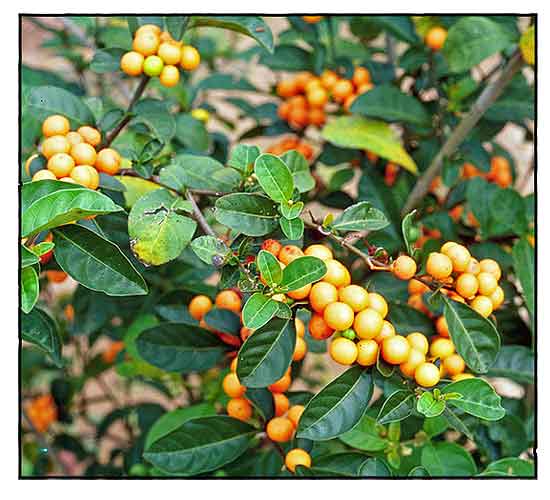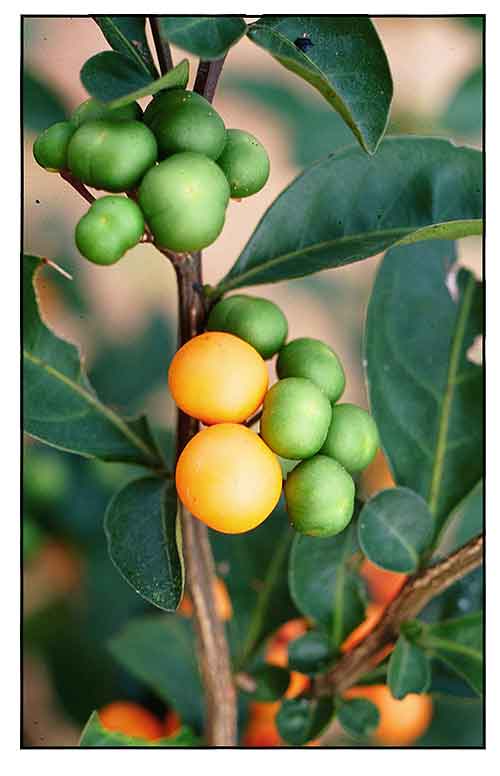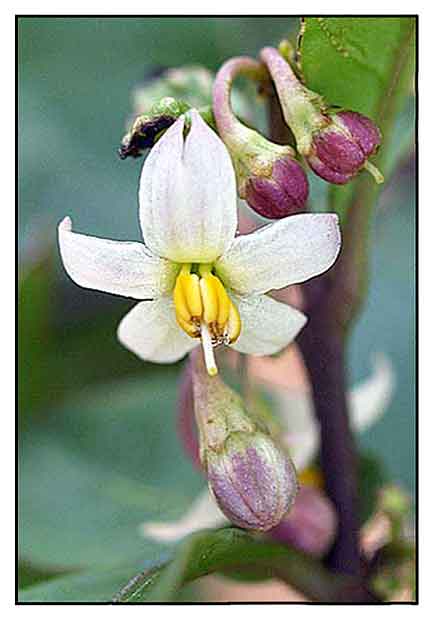 Gen info Gen info
- Solanum is a large and diverse genus of flowering plants, which include three economically important food crops: potato, tomato, and eggplant. It is the largest genus in the nightshade family Solanaceae with about 1,500 species.
-
Solanum diphyllum is a species of nightshade native to the Americas, under the diverse nightshade family, Solanaceae. It was first described by Carl Linnaeus in his 1753 book Species Plantarum. (1)
- Twoleaf nightshade is sometimes confused with Jerusalem cherry (Solanum pseudocapsicum), another nightshade with brightly colored berries.
- The genus name Solanum derives from Latin solamen, meaning "comforting or soothing". An etymologic alternative is the Latin word sol, meaning "sun", referring to it being a plant of the sun. Specific epithet diphyllum means "two leaf", referring to the arrangement of the leaves, growing in pairs from a single bud.
- Solanum diphyllum is most similar to S. malacothrix, a rare species from western Mexico
, sharing in small flowers with reflexed petals at anthesis and berries borne on erect pedicels. S. diphyllum differs from S. malacothrix in its glabrous foliage. (7)
 Botany Botany
Twoleaf nightshade is a small shrub about 1 to 2 m (3.3 to 6.6 ft) tall. The stems are smooth or sometimes slightly downy with a dark brown bark. Leaves grow in pairs from a single bud, hence the name 'twoleaf'. Each pair is composed of a major and a minor leaf. Major leaves average around 6 cm (2.4 in) long by 2 cm (0.79 in) wide and are elliptic to oblong in shape. Minor leaves are smaller and more rounded; 2 cm (0.79 in) long by 1 cm (0.39 in) wide on average. Leaves are a glossy dark green on the upper surface with a lighter green on the ventral side. The petioles are about 2 mm (0.079 in) in length. Inflorescences are borne opposite the leaves, each bearing about 5 to 20 closely spaced flowers. Flower buds are white and globular when young but become more lavender in color and elongated as they mature. which bloom into tiny white flowers with a lavender tinge about 1 cm (0.39 in) across. Fruits are spherical berries with a slight division around the middle, especially when unripe; green and hard when young, around 1 cm (0.39 in) in diameter; maturing into bright yellow to orange fleshy and juicy berries about 1.2 cm (0.47 in) in diameter, mounted on the flower calyces on long and thin pedicels. Each berry contains numerous seeds. Seeds are flattened and kidney-shaped (resembling bell pepper seeds), each about 3 mm (0.12 in) long and 2.5 mm (0.098 in) wide, with pale margins and are minutely pitted. (1)
Shrubs glabrous. Stems erect, 0.5-2 m tall, young stems angled proximal to nodes from decurrent leaf bases, otherwise terete. Leaves unequal paired; petiole of major leaf 1-1.5 cm, winged by leaf bases; blade of major leaf elliptic to oblong, sometimes broad, 4-9 × 2-3.5 cm, base attenuate and decurrent on petiole and stem, margin entire, apex rounded; minor leaves subsessile, blade rounded, 1.5-3 × 1.2-2.2 cm, entire. Inflorescences leaf opposed, short scorpioid racemes, often subumbellate; peduncle unbranched, 3-12 mm, later bearing conspicuous pedicel scars. Pedicel 5-12 mm, erect at anthesis. Calyx constricted at base and just proximal to lobes, 2-2.5 mm; lobes deltate, ca. 1 mm, minutely ciliolate. Corolla white, 3.5-4.5 mm, lobed ca. 3/4 way to base. Filaments short; anthers 1-1.5 mm. Ovary glabrous. Style 3-4 mm. Fruiting pedicel erect, 0.8-1.4 cm. Berry orange, globose, slightly 2-lobed, 7-12 mm in diam. Seeds yellow or tan, reniform-discoid, ca. 3 × 2 mm, margins thickened. (Flora of China)
Distribution
- Introduced.
- Naturalized.
- Native to Belize, Costa Rica, Guatemala, Honduras, Mexico, Nicaragua. (2)
- Ornamental cultivation.
 Constituents Constituents
- Study of methanolic extract of roots isolated a highly cytotoxic compound, named 3-O-(ß-D-glucopyranosyl) etioline [(25S)-22,26-epimino-3ß-(ß-D-glucopyranosyloxy) cholesta-5-22(N)-dien-16α-ol]. (see study below) (3)
- Qualitative phytochemical screening of methanol extract of leaves
yielded carbohydrates, proteins and amino acids, tannins and phenols, saponin, flavonoid, terpenoids, alkaloids and glycosides, with absence of steroids and anthraquinone. (see study below) (4)
- Leaf extract showed highest total polyphenol content (68.1 mg GAE/g), followed by stems (48.6 mg GAE/g), fruits (38 mg GAE/g), and roots (26 mg GAE/g). (see study below) (6)
- Phytochemical screening of distilled water (W), methanol (M), acetone
(A), n-hexane (H) leaf extracts yielded alkaloids (++WMAH), carbohydrates (+WMAH), glycoside (+W,A), saponin (+WMA++H), flavonoids (+WMA++H), tannins (M), proteins (MH), with absence of phenols. (9)
Properties
- Toxicity: Plant is listed as poisonous.
-
Studies have suggest cytotoxicity, anticancer, antioxidant, α-amylase and α-glucosidase inhibitory, antibacterial properties.
Parts used
Seeds, roots, leaves, fruits.
Uses
Edibility
- The plant is listed as poisonous. While the fruit is reportedly edible to birds, it is not known if fruit is harmless to humans. Since most members of the family are toxic, human consumption is not advised.
Folkloric
- In India, Kanikkar tribe use seeds for treatment of intestinal worms.
- In Uttar Pradesh, India, fruits used as tonic and laxative, to improve appetite, and for treatment of asthma and skin diseases. Green fruits are crushed and applied on ringworm. Dried seeds are fried in oil and taken as vermifuge. (5)
Studies
• Cytotoxicity / Anticancer / Roots: Study of methanolic extract of Solanum diphyllum roots isolated a highly cytotoxic compound, named 3-O-(ß-D-glucopyranosyl) etioline [(25S)-22,26-epimino-3ß-(ß-D-glucopyranosyloxy) cholesta-5-22(N)-dien-16α-ol]. The compound exhibited high cytotoxic effects against cervical cancer cell line, HeLa cells, with IC50 of 150 µg/mL. (3)
• Antioxidant / Leaves: In a study of wild Solanum species for phytochemicals and antioxidant potential, Solanum diphyllum displayed highest ABTS scavenging efficiency (86.21%) with EC50 value of 6.2 mg/ml. Water extract showed total phenol of 1.32 mg GAE/g, 21.02 % DPPH scavenging activity. Methanol extract showed reducing potential of 47.76 mg AAE/g, DPPH activity of 10.36 mg GAE/g, ABTS activity of 5.6t4 mg TBHQ/g, H2O2 activity of 35.37 mg AAE/g, and NO activity of 67.52 mg TBHQ/g,(see constituents above) (4)
• Antioxidant / α-Amylase and α-Glucosidase Inhibitory Activity / Leaves: Study evaluated total phenolic content, antioxidative, anti-α-amylase and anti-α-glucosidase activities in powder extracts of fruits, leaves, roots, and stems of Solanum diphyllum. Using DPPH, reducing power, Fe-chelating and total antioxidant assays, the leaf and stem extracts showed promising anti-oxidative activity. Stem extract showed highest α-amylase and α-glucosidase inhibition at concentrations of 1.0 and 0.5 mg/ml, respectively. (see constituents above) (6)
• Antibacterial / α-Amylase and α-Glucosidase Inhibitory Activity / Leaves: The methanol, acetone and n-hexane extracts of seven Solanum species (S. nigrum, S. villosum, S. torvum, S. surratense, S. sysimbrifolium, S. diphyllum,and S. incanum) showed significant antibacterial properties against S. aureus, B. subtilis, P. vulgaris, S. typhi and E. coli, and the inhibition zone ranged from 7 to 16.66 mm. The methanol extract of S. diphyllum showed antibacterial activity of 19.0, 16.33, 13.33,13.33, 8.33, respectively. (see constituents above) (9)
• Anticancer / Roots, Shoots, Fruit: Root, shoot and fruit methanolic extracts of Solanum diphyllum L exhibited cell viability decreasing in a concentration-dependent manner and potent activity against variety of carcinoma cell Lines (breast MCF7, colon HCT116, and hepatoma cancer cells) with relatively mild effect on normal cell line. Study suggests potential anti-cancer effect. (10)
Availability
Wild-crafted.
|

![]()






